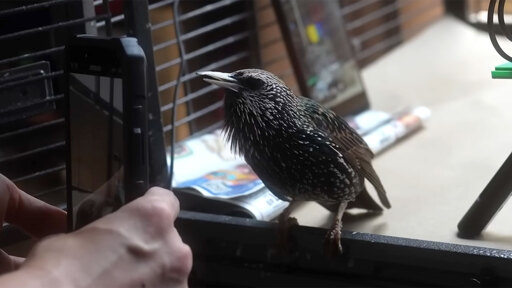A music and science lover has revealed that some birds can store and retrieve digital data. Specifically, he converted a PNG sketch of a bird into an audio waveform, then tried to embed it in the song memory of a young starling, ready for later retrieval as an image. Benn Jordan made a video of this feat, sharing it on YouTube, and according to his calculations, the bird-based data transfer system could be capable of around 2 MB/s data speeds.



If your argument is that the bandwidth calculation is incorrect, then sure I think that’s fair.
But I don’t think it’s correct to say it’s not a digital channel juts because it doesn’t have optimal bandwidth.
Gozz is correct. You’re misunderstanding the nature of a digital signal. What the author did was convert a digital signal to an analog signal, store that analog signal on a bird, then record that analog signal. Whether it was redigitized after the fact is irrelevant. It is not a digital process end-to-end. This is the same as if I were to download a YouTube video, record that video on a VHS tape, then redigitize that video. Not only would the end result not be a bit for bit match, it wouldn’t be a match at all despite containing some of the same visual information, because it would be the product of a digital-analog-digital conversion.
The bird drawing is just a proxy for arbitrary data. In your example, you could convert bitstream into a pattern of black and white squares into a YouTube Video. Send it through the VHS channel, and when you digitize it, you would get back the exact bitstream.
Yes, that would be a digital modulation. That is decidedly not what is being done with the bird. The input data is the “PNG” of the bird, which is then not digitally modulated, but converted to an analogue signal and later redigitized. If the file has been converted to a series of pulses at different frequencies (the equivalent of your black and white squares) that would be a digital modulation. I am not arguing that this is not possible. My original comment explicitly says I would like to see a follow up with actual modulation. But just because it is possible to run dialup over an analogue phone line does not mean that calling your grandma on that same phone is a digital communication system. Some computers back in the day could modulate and record data on commercial audio cassettes. That does not mean that if I record something off the radio and play it back later that’s a digital copy of the song.
It isn’t a digital channel because it does not reproduce digital data. Unless it’s a one-bit signal of “does this look like a bird? yes/no”, but then the human making that assessment is part of the channel. To claim this is a digital system would require us to be so reductive as to redefine the meaning of the word.
If we’re being pedantic, shouldn’t we consider that it can be a one bit signal? Otherwise you should be specific about what bandwidth you’d consider digital.